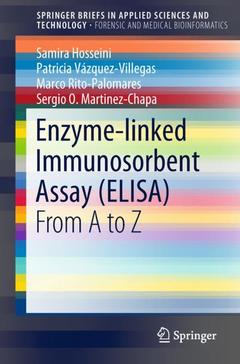Description
Enzyme-linked Immunosorbent Assay (ELISA), 1st ed. 2018
From A to Z
SpringerBriefs in Forensic and Medical Bioinformatics Series
Authors: Hosseini Samira, Vázquez-Villegas Patricia, Rito-Palomares Marco, Martinez-Chapa Sergio O.
Language: English
Subjects for Enzyme-linked Immunosorbent Assay (ELISA):
Keywords
Side Chain Theory; Antigen-antibody Binding Theory; Radioimmunoassay (RIA); Antibody Production; Humoral Immunity; Cancer Detection; Antispecies Antibodies; Enzyme Conjugation; Chemifluorescenct Assay; Covalent Immobilization; Plasmonic ELISA; ELISA in Microdevices; Protein-Ligand Interactions
68.56 €
In Print (Delivery period: 15 days).
Add to cartSupport: Print on demand
Description
/li>Contents
/li>Biography
/li>Comment
/li>
Dr. Samira Hosseini obtained her B.Sc. degree in Applied Physics, her M.Sc. degree in Polymer Chemistry and her PhD degree in Biomedical Engineering. Currently, she is working as a Postdoctoral Researcher at the School of Engineering and Sciences, Tecnológico de Monterrey, Mexico. She is the author/co-author of more than 15 ISI indexed scientific publications, 12 book chapters and the inventor/co-inventor of 4 Intellectual properties. She is a member of the Mexican National System of Researchers. Her main areas of research are surface engineering, interface science, bioanalytical assays and polymeric materials.
Dr. Patricia Vázquez-Villegas obtained her Bachelor’s degree in Food Sciences Engineering program in 2008 and her PhD in Engineering Sciences from Tecnológico de Monterrey, Monterrey, México in 2013 majoring in Biotechnology. She made a one-year internship in 2012 at the University of British Columbia, Vancouver, Canada under the supervision of Dr. Charles A. Haynes. Since 2014 she holds a Postdoc position in Tecnológico de Monterrey where she is working in the development and application of platforms for purification and detection of different kinds of biomarkers. Dr. Vázquez is the author/co-author of 8 ISI indexed scientific publications, 1 book chapter and the inventor/co-inventor of 4 intellectual properties. She is a member of the Mexican National System of Researchers. Her main contribution had been in the field of continuous recovery of biomolecules using liquid–liquid extraction.Professor Rito-Palomares obtained his PhD in Chemical Engineering from The University of Birmingham, United Kingdom in 1995. Following a sabbatical in the Department of Chemical Engineering at the University of Cambridge, United Kingdom (2001)., Prof. Rito-Palomares is currently the Director of the Biotechnology Centre and a Full Professor at Tecnologico de Monterrey, Mexico. He is a member of the Mexican Academy of Sciences, scientific committee of theIncludes supplementary material: sn.pub/extras
These books may interest you

ELISAMethods and Protocols 121.31 €

ELISAMethods and Protocols 168.79 €

Enzyme-Mediated Immunoassay 52.74 €

